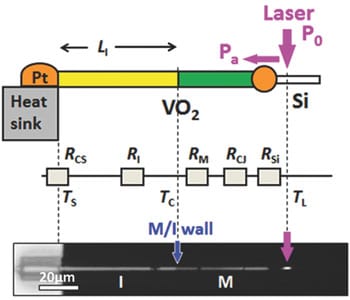Researchers from the University of California, Berkeley, South University of Science and Technology of China, and Hong Kong University of Science and Technology have developed a microscale powermeter that directly measures light absorption and heat transfer in individual nanowires.

Near-field power meter (Cheng et al.)
Absorption and propagation of light at length scales shorter than the wavelength is a key process for many technologies in modern photovoltaics. Similarly, heat exchange and transfer at length scales shorter than the phonon mean free path is critically important for nanoscale thermal management. For such microscale energy conversion and transfer, gauging the energy flow has up until now either been done indirectly or required complicated tools.
In the group’s research, a near-field powermeter is demonstrated based on the metal-insulator transition in an oxide material, vanadium dioxide (VO2). VO2 undergoes phase transition from the insulating phase to the metallic phase when its temperature passes 67 oC, while these two phases appear with very different colours under optical microscopy. When VO2 is made into a single-crystal nanobeam, where the tip is heated with a focused beam of laser, the tip part of the nanobeam transitions into the metallic phase while the rest is still insulating; the optically resolved metal-insulator domain wall provides the marker for a microscale thermometer. In response to variation of the laser heating power, the domain wall moves along the VO2 nanobeam frictionlessly, akin to a glass tube thermometer. After calibration, the position of the domain wall is related to the absolute laser power absorbed at the tip of the nanobeam. The light absorption of a single nanobeam/nanowire has been difficult to measure directly, and it is routinely evaluated using analytical equations or simulation. This work, the researchers believe, provides a direct measurement of light absorption of individual nanowires.
The powermeter is contactless and optically read, allowing quick determination of local temperature, optical absorbance, thermal conductivity, and contact thermal resistance of the VO2 nanobeam. When another nanowire made of other materials is bonded to this VO2 nanobeam, these properties of that nanowire can also been quantified. Currently, the powermeter works near room temperature; however, as the phase transition temperature of VO2 can be tuned by doping, the operating temperature range of the powermeter can also be tuned. Combined with spatio-temporally resolved techniques such as laser pumping and probing, it is possible to extend this tool to the time domain for direct quantification of charge and phonon dynamics in individual nanowires.

















